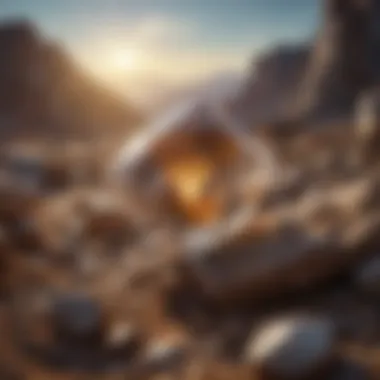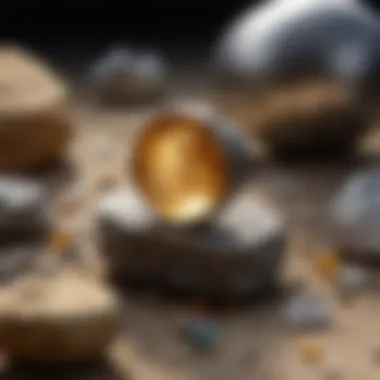Unveiling the Intricacies of Diamond Hunting: A Thorough Guide for Fossil Enthusiasts


Rock and Fossil Identification
In the captivating realm of diamond digging and collecting rocks and fossils, identification serves as the foundational step. Various types of rocks and fossils exist, each with distinctive characteristics waiting to be discovered by the discerning enthusiast. When embarking on this journey, it is essential to pay close attention to the fine details, as they often hold the key to unveiling the true nature of these geological treasures.
To aid in the identification process, a range of specialized tools are utilized by collectors. These tools play a crucial role in closely examining the texture, color, and composition of rocks and fossils, allowing for precise classification and cataloging. Thus, arming oneself with the appropriate tools is a fundamental aspect of becoming adept at distinguishing between different types of geological specimens.
Collecting Tips and Techniques
As enthusiasts delve deeper into the world of rock and fossil collection, a set of best practices emerge to guide them on their quest for remarkable discoveries. Understanding how to navigate and locate prime collecting sites is paramount, as these locations hold the promise of uncovering hidden gems beneath the earth's surface. Implementing systematic techniques ensures a successful and fruitful collection expedition, where patience and persistence are often rewarded with rare and prized finds.
When it comes to safely extracting specimens, delicacy and precision are key. Careful excavation techniques help preserve the integrity of the rocks and fossils, preventing any damage that could diminish their scientific or aesthetic value. By following established guidelines for extraction, collectors can enhance their collection with minimal impact on the specimens and their surrounding environment.
Preservation and Display
Preserving the beauty and integrity of collected rocks and fossils is a significant aspect of this journey. Various techniques exist for safeguarding these geological wonders, ranging from meticulous cleaning methods to protective coatings that shield them from deterioration. Moreover, adopting proper storage practices ensures the longevity of specimens, allowing future generations to marvel at these natural marvels.
Creative display ideas offer collectors the opportunity to showcase their prized acquisitions in unique and engaging ways. By incorporating elements of design and innovation, enthusiasts can create visually stunning displays that not only highlight the splendor of rocks and fossils but also educate and inspire viewers about the wonders of the earth's geological history.
Geological Insights
Delving into the geological insights surrounding rocks and fossils enriches the collector's understanding of these artifacts. Exploring the formations and processes that shaped these specimens over millennia unveils the intricate tapestry of earth's history, providing insights into the forces that have sculpted our planet. Additionally, uncovering the historical significance and notable discoveries in the field offers a glimpse into the scientific contributions and exciting breakthroughs that continue to captivate rock and fossil enthusiasts worldwide.
Introduction to Diamond Digging
Diamond digging holds a significant place in the realm of rock and fossil collection due to its intricate process and the allure of unearthing precious gems. This section serves as the cornerstone of the article, providing a comprehensive overview of the essential aspects crucial for enthusiasts venturing into the world of diamond exploration. By delving into the geological formations and tools required for successful expeditions, readers can gain a profound understanding of the meticulous process involved in diamond digging.
Unveiling the Fascination of Diamond Mining
The allure of uncovering precious gems
The allure of uncovering precious gems lies in the thrill of discovering nature's precious gifts hidden beneath the Earth's surface. This captivating aspect of diamond digging not only appeals to collectors seeking unique specimens but also adds an element of excitement to the exploration process. By unraveling the mysteries of diamond formation and extraction, enthusiasts can witness the beauty of these gems in their raw, untouched state, creating a truly enriching experience in the world of rock and fossil collection.


The historical significance of diamond mining
The historical significance of diamond mining traces back centuries, highlighting the enduring fascination with these exquisite gemstones. From ancient civilizations to modern-day industry, diamond mining has played a pivotal role in shaping economies and cultures worldwide. Exploring the historical context of diamond extraction offers invaluable insights into the evolution of mining techniques and the enduring allure of these precious stones, enriching collectors' understanding of the vast legacy behind each discovered gem.
The Science Behind Diamonds
Formation of diamonds in the Earth's crust
The formation of diamonds in the Earth's crust unveils the intricate process by which carbon transforms under immense pressure to create these coveted gemstones. Understanding this scientific phenomenon provides enthusiasts with a deeper appreciation for the geological forces at play beneath the Earth's surface. By exploring the chemical composition and environmental conditions necessary for diamond crystallization, collectors can grasp the rarity and significance of each unearthed gem.
Geological conditions favoring diamond deposits
Geological conditions favorable for diamond deposits offer invaluable insights into the specialized environments where these precious gems thrive. By elucidating the unique geological formations and factors conducive to diamond formation, this section equips enthusiasts with the knowledge essential for successful diamond hunting. From volcanic eruptions to tectonic shifts, exploring the geological landscapes that give rise to diamond-rich regions illuminates the intricate relationship between Earth's processes and the creation of these exceptional gems.
Essential Tools for Diamond Digging
In the realm of diamond digging, having the right tools is paramount for success. The section on 'Essential Tools for Diamond Digging' within this comprehensive guide sheds light on the crucial elements necessary for rock and fossil collectors to delve into this intricate process. By outlining specific elements, benefits, and considerations about the essential tools required, enthusiasts can elevate their diamond hunting experience.
Selecting the Right Equipment
Shovels, Sieves, and Pickaxes
Shovels, sieves, and pickaxes play a pivotal role in the process of diamond digging. The versatility and sturdiness of these tools make them indispensable for collectors aiming to unearth precious stones. Shovels are adept at excavating soil efficiently, while sieves aid in separating diamond-bearing materials from debris. As for pickaxes, their sharp ends are perfect for breaking through tough layers of earth, making them a popular choice among seasoned diggers. Despite their advantages, these tools require proper handling and maintenance to ensure longevity in the demanding field of diamond excavation.
Proper Attire for Diamond Exploration
When embarking on a diamond exploration journey, appropriate attire is not just a preference but a necessity. The right clothing and gear can safeguard collectors from the elements and potential hazards, allowing them to focus on their quest for valuable stones. From durable boots to protective eyewear, each piece of attire serves a specific function in ensuring the safety and comfort of individuals navigating rough terrains. While the right attire enhances the overall diamond digging experience, it is crucial to strike a balance between functionality and comfort to optimize efficiency and mobility in the field.
Understanding Soil Composition
Types of Soil Conducive to Diamond Formation


The composition of soil plays a crucial role in the formation of diamonds, with certain types proving more favorable for the natural crystallization process. Understanding the characteristics of soil conducive to diamond formation enables collectors to pinpoint potential hotspots for their excavation efforts. Soils rich in carbon and minerals provide an ideal environment for diamond growth, offering valuable insights into the geological conditions necessary for gemstone creation. By identifying and analyzing these soil types, collectors can strategically plan their diamond hunting expeditions for higher chances of success.
Impact of Soil Conditions on Diamond Discovery
The impact of soil conditions on diamond discovery cannot be understated, as different soil properties directly influence the visibility and accessibility of buried gems. Factors such as moisture content, p H levels, and mineral composition all contribute to the overall prospecting prospects within a given region. By examining the interplay between soil conditions and diamond distribution, collectors can adapt their excavation techniques to maximize productivity and optimize their chances of unearthing rare specimens. Awareness of how soil conditions affect diamond discovery is crucial for rock and fossil collectors seeking to master the art of diamond digging.
Strategies for Successful Diamond Hunting
To excel in the thrilling pursuit of diamond hunting, meticulous planning and strategic maneuvers are imperative. In this section, we will delve into the core strategies that ensure a fruitful exploration journey. Diamond hunting demands more than just luck; it requires a profound understanding of geological indicators and excavation techniques. By mastering these strategies, rock and fossil collectors can significantly enhance their chances of unearthing precious gems.
Locating Promising Sites
Researching geological maps and surveys
Researching geological maps and surveys is a pivotal aspect of successful diamond hunting. These invaluable resources provide crucial insights into the geological structures and composition of potential diamond-rich areas. By analyzing these maps, collectors can identify regions with a high probability of containing diamonds, optimizing their search efforts. The detailed information obtained from geological surveys acts as a reliable guide, enhancing the efficiency of the exploration process. However, it is essential to interpret these maps accurately and stay updated with the latest geological data to maximize the chances of discovery.
Identifying diamond-rich regions
Identifying diamond-rich regions is a fundamental step in the pursuit of diamonds. By focusing on areas known for their diamond deposits, collectors can streamline their search and increase the likelihood of finding valuable specimens. These regions are characterized by specific geological features that create a conducive environment for diamond formation. Conducting thorough research and leveraging geological knowledge are essential for pinpointing these hotspots. While these regions offer exciting prospects for discovering diamonds, it is crucial to navigate potential challenges, such as land accessibility and geological diversity, to ensure a successful and ethical exploration process.
Excavation and Extraction Techniques
Digging methods for diamond recovery
Efficient digging methods play a critical role in the retrieval of diamonds from the earth. Collectors must employ precise techniques to excavate diamond-bearing material without causing damage to the specimens. By selecting the appropriate tools and adopting strategic digging practices, collectors can optimize their chances of recovering intact diamonds. Understanding the geological context and composition of the excavation site is paramount in determining the most effective and safe digging methods for diamond retrieval.
Handling and preserving discovered diamonds
Once diamonds are unearthed, proper handling and preservation are essential to ensure their integrity and value. Delicate handling practices are vital to prevent any damage to the precious gems during extraction and transportation. Specialized techniques for cleaning and storing diamonds safeguard their brilliance and authenticity. Collectors must adhere to best practices for diamond preservation to retain the gem's quality and beauty. By mastering these handling and preservation techniques, collectors can secure their valuable discoveries for future appreciation and study.
Ethical and Legal Considerations in Diamond Digging


In the realm of diamond digging, ethical and legal considerations play a pivotal role, shaping the foundation of responsible practices for enthusiasts and collectors alike. Understanding and abiding by these regulations not only ensure the protection of the environment and wildlife but also uphold the integrity of the entire diamond mining process. Ethical guidelines encompass a range of aspects, from sustainable mining practices to fair labor conditions, aiming to create a positive impact on both the ecosystem and local communities. Legal considerations, on the other hand, focus on adherence to regional mining laws and regulations to prevent any unauthorized or unlawful activities that could harm the environment or lead to exploitation.
Environmental Impact Awareness
Minimizing Ecological Footprint
Minimizing ecological footprint stands as a cornerstone in the ethical framework of diamond digging, emphasizing the importance of reducing the environmental impact of mining activities. By implementing sustainable practices that minimize waste generation, limit carbon emissions, and preserve natural habitats, collectors can contribute significantly to the conservation of fragile ecosystems. The key characteristic of minimizing ecological footprint lies in its ability to promote long-term environmental sustainability while fostering ecological balance. This choice not only benefits the natural surroundings but also promotes a greener and more conscientious approach to diamond excavation.
Respecting Wildlife Habitats
Respecting wildlife habitats is a fundamental aspect of ethical diamond digging, underscored by the need to safeguard the diverse flora and fauna that inhabit mining regions. By adopting measures to protect and preserve wildlife habitats, collectors can mitigate the disruption of ecosystems and minimize the risk of endangering species. The unique feature of respecting wildlife habitats lies in its dual objective of conservation and coexistence, ensuring that diamond mining activities harmonize with the natural environment. While this approach enhances biodiversity and ecological resilience, it may require careful planning and monitoring to balance extraction with habitat preservation.
Compliance with Mining Regulations
Permit Requirements for Diamond Excavation
Compliance with permit requirements for diamond excavation is essential to maintain legality and accountability in the mining sector. Obtaining the necessary permits not only legitimizes diamond digging operations but also demonstrates a commitment to responsible and regulated practices. The key characteristic of permit requirements lies in their role in ensuring transparency and monitoring of mining activities, safeguarding against unauthorized or harmful operations. By adhering to permit regulations, collectors can contribute to the sustainable management of diamond resources while bolstering trust within the industry.
Ensuring Ethical Sourcing Practices
Ensuring ethical sourcing practices is a fundamental ethical consideration for diamond collectors, focusing on the origin and supply chain of mined diamonds. By prioritizing ethical practices such as fair trade, responsible sourcing, and conflict-free diamonds, collectors can support socially responsible mining initiatives. The unique feature of ethical sourcing practices lies in their capacity to empower communities, protect human rights, and promote sustainable development in diamond mining regions. While implementing such practices may require additional diligence and oversight, the advantages of ethical diamond sourcing extend beyond individual collections to contribute positively to the broader industry.
Safety Precautions for Diamond Diggers
In a comprehensive guide on the art of diamond digging, safety precautions play a pivotal role in ensuring a secure and productive exploration experience. With the potential risks associated with excavation activities, being well-prepared with appropriate safety measures is paramount for every diamond digger.
Protective Measures in the Field
Risk Assessment and Hazard Prevention
When it comes to risk assessment and hazard prevention, meticulous attention to detail is essential for mitigating dangers inherent in diamond digging. Conducting a thorough assessment of the excavation site helps in identifying potential hazards such as unstable terrain or environmental risks. By implementing proactive measures to prevent accidents, diamond diggers can safeguard themselves and their team members, ensuring a safe working environment.
First Aid Preparedness for Emergencies
First aid preparedness plays a crucial role in responding effectively to unforeseen emergencies during diamond digging expeditions. Equipping oneself with first aid knowledge and supplies can make a significant difference in addressing injuries or medical situations promptly. Being prepared to administer aid in critical situations can be a life-saving skill for diamond diggers, emphasizing the importance of prioritizing safety and well-being.
Health and Wellness Guidelines
Maintaining adequate hydration and sun protection are paramount for sustaining energy levels and protecting against sun-related health risks. In the field of diamond digging, where physical exertion under the sun is common, staying hydrated and wearing appropriate sun protection gear are essential practices. Recognizing signs of exhaustion and dehydration is key to preventing health complications, allowing diamond diggers to prioritize their well-being while immersed in the exhilarating pursuit of diamond exploration.







